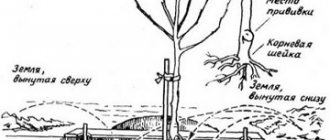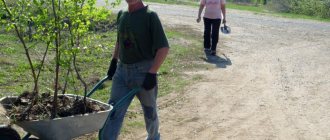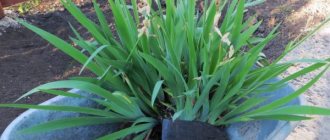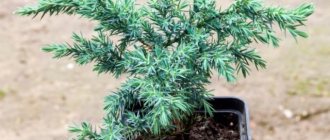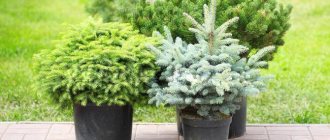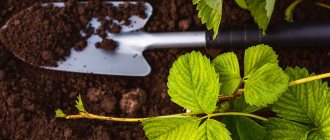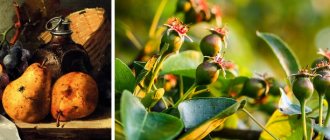Popular types and varieties of sea buckthorn
There are two types of sea buckthorn: willow-leaved (not found in Russia), and buckthorn (a species that grows in our country, shown in the photo below).
Popular varieties of sea buckthorn:
- Botanical;
- Altai;
- Moscow pineapple;
- Jam;
- Elizabeth;
- Giant;
- Gift of Katun;
- Excellent;
- Self-fertile;
- Golden Cob;
- Pepper;
- Amber;
- Solar;
- Chuyskaya;
- Essel.
Also among the male specimens one can distinguish the sea buckthorn varieties “Alei”, “Gnome”, “Ural”, “Dear Friend”.
By the way! Sea buckthorn begins to bear fruit 3-4 years after planting in open ground.
How to distinguish male from female sea buckthorn (photo)
The peculiarity of the culture is that it is a dioecious plant, so the buds of sea buckthorn are male and female, and they are found on different individuals. It is by the buds that it is easiest to distinguish a male sea buckthorn plant from a female one. In male sea buckthorn they are located at the base of young shoots, in female bushes they are in the axils of the covering scales. Male buds are larger and collected in the likeness of spike-shaped inflorescences.
How to distinguish female sea buckthorn from male sea buckthorn - photo below.
The difference between male and female sea buckthorn trees can also be detected by the shape of the leaves. The leaf plate of a male plant is flat, while that of a female plant is curved in the shape of a bowl. The differences between boy and girl sea buckthorn are also in the shape of the flowers and their color. Female flowers are yellowish, collected in inflorescences, male flowers are silvery, greenish.
You can also determine the sex of a shrub by the color of the crown at the end of spring. Male bushes have a characteristic bluish bloom, while the foliage of females will remain bright green.
A video on how to distinguish male sea buckthorn from female sea buckthorn is presented below.
Features of choosing sea buckthorn seedlings
It is very important to know one feature of sea buckthorn: the culture is dioecious, pollination occurs in a cross manner , therefore, in order to bear fruit, “female” and “male trees” must grow next to each other . The male specimen is needed solely for pollination (berries do not grow on them), but berries appear on the female specimens.
Note! On your site, you must definitely plant “male” and “female” sea buckthorn seedlings, because without a male pollinator, the female shrub will not be pollinated, and therefore will not bear fruit.
Even if you have several female bushes, it is enough to have only one male tree, but it should grow no further than 10 meters.
How to distinguish male and female specimens? The main distinguishing feature is the kidneys:
- Male sea buckthorn has large buds with 5-7 covering scales.
- But female specimens have buds two to three times smaller than male ones, they have only 2 covering scales.
The easiest time to identify them is in the spring before the flowers bloom. However, this is not difficult to do even in summer; if there are berries on the bush, then it is definitely a female tree.
The photo below shows the differences between male and female sea buckthorn:
This picture also illustrates the differences: 1 is a female sea buckthorn, 2 is a male one.
Important! Sea buckthorn has a short dormant period; the tree may begin to vegetate during the first thaw. Therefore, if you want a tree to grow on your site for many years and successfully bear fruit, you need to buy only seedlings of zoned varieties of sea buckthorn that are suitable for growing in your climate zone. Otherwise, the tree may begin to grow too early and will easily freeze and die.
Harvesting and processing
The harvest time for sea buckthorn berries depends on the characteristics of the variety. Thus, the fruits of early ripening crops can be picked at the end of August. For late-ripening varieties, the harvesting period is delayed to mid-September. Ripe berries have an intense color and are easily torn from the stalks.
Some gardeners collect sea buckthorn fruits after the first frost in cloudy weather. Under such conditions, the fruits are much easier to separate from the branches.
The collection of sea buckthorn must take into account the following rules:
- Before starting work, put on rubber gloves and an apron. Protective clothing will prevent juice from getting on the skin and will also protect the collector from sharp thorns.
- The fruits are picked from the top to the bottom of the branches.
- Some gardeners harvest the fruits with tongs, but the harvesting process is very slow.
- Devices such as a scraper, a cobra with steel wire, and a slingshot with a stretched line help speed up the process.
If the berries are going to be processed into juice, but you don’t want to pick them, you can put on rubber gloves and place the container under the branch. As a result of successive movements from top to bottom along with squeezing the berries, up to 4 liters of juice per hour are obtained. Ripe berries that have been frozen can be easily shaken off the tree onto a distributed film or cloth.
Many people know about the benefits of sea buckthorn; its fruits and leaves contain a huge amount of vitamins, amino acids and other active substances. The collected berries are washed and dried, placed in plastic bags and stored in the freezer. In addition, the fruits can be sprinkled with sugar and placed in the refrigerator in plastic containers. Also, jam is made from fresh sea buckthorn, the juice is squeezed out and the oil is extracted.
When to plant sea buckthorn in the fall: optimal timing
In order for the seedling to take root normally in a new place and not freeze out during the first frost, it is very important to plant it at the most appropriate time. When is the best time to plant sea buckthorn in the fall? Planting in open ground should be done 3-4 weeks before the first frost , so that the seedling has time for normal rooting and adaptation in the new place.
Also, when choosing the timing, you should focus on temperature conditions: the optimal temperature for the procedure:
- during the day - 10-15 degrees Celsius;
- at night - 5 degrees Celsius.
It is quite difficult to name the exact date for the procedure, because our country has different weather and climatic conditions. Thus, the timing of planting sea buckthorn seedlings in the fall is different:
- South - all October;
- Middle zone (Moscow region) - the end of September and the first half of October;
- Siberia, Ural, Leningrad region - all September.
When is the best time to plant: spring or autumn
Sea buckthorn can be planted in both spring and autumn. However, spring planting is preferable. As mentioned above, the plant can begin to grow at the very first thaw, and due to the fact that the seedling has not yet had time to adapt, it can easily freeze. In general, seedlings planted in spring take root better and adapt to a new place in the open ground.
In regions with relatively warm winters, for example, the Krasnodar Territory (Kuban), the North Caucasus, you can plant in both spring and autumn.
But in the middle zone (Moscow region), Siberia, the Urals, and the Leningrad region, it is better to plant the crop in the spring. However, if you are specifically interested in the autumn period, you can carry out the procedure in the fall. But you must follow all the rules and schemes, and then carefully protect and prepare the seedling for winter.
Interesting fact! The name of the tree-like shrub is connected with the fact that the berries abundantly cling to the shoot. But the plant also has another name - “sea thorn”; it received this name due to the fact that in its natural environment it grows on the banks of reservoirs (rivers, seas).
Pests and diseases
In central Russia, specific pests and diseases on sea buckthorn are rare. However, most often it is affected by green aphids. In this case, the leaves of the plants curl, turn yellow and fall off, the growth of shoots and the ripening of berries slow down.
When endomycosis occurs, light spots appear on the fruits, the berries soften and become discolored, and when scab occurs, the leaves and fruits become covered with black spots.
Often, plants or individual branches of sea buckthorn dry out from harmful fungi that attack them. Such plants are usually uprooted.
To combat diseases and pests in the spring, before the buds open, sea buckthorn can be sprayed with nitrafen (300 g per 10 liters of water) or other suitable preparations, and on the leaves with Bordeaux mixture.
How to plant sea buckthorn in open ground in the fall: preparation, rules, diagrams
The procedure can be divided into several key stages: choosing a location, preparing the site and planting hole, and direct planting. Let's look at each stage in detail.
Advice! When planting in autumn, it is better to plant several seedlings at once, in case one specimen freezes out. If all the seedlings survive the winter, then you will have several healthy bushes.
Which place is suitable for planting sea buckthorn
Fruit and berry crops do not tolerate transplantation to a new location, so you must immediately approach the selection of a site for cultivation responsibly. Where is the best place to plant crops in the garden? For planting, it is best to choose a place on the site according to the following recommendations:
- The crop is sun-loving, so you need to plant it in sunny, open areas with good lighting . When grown in shady places, you should not expect a large harvest.
- The place should be protected from strong winds and drafts (especially from the north!).
Advice! But a male sea buckthorn seedling, on the contrary, needs to be planted on the windward side.
- Sea buckthorn has a superficial root system with long branched roots, the bulk of the roots are located at a depth of about 30-40 centimeters. For this reason, the crop should not be planted: Near trees and shrubs with a superficial root system . Otherwise they will compete for nutrients and moisture.
- Near areas where deep digging of the earth is carried out (with a shovel or cultivator), otherwise the roots can be easily damaged.
- Too close to any buildings (house, utility block, barn, summer kitchen).
Important! When planting sea buckthorn, be sure to maintain a distance between the seedling of this crop and other trees, shrubs, buildings, structures, and the active digging area. The gap should be at least 5-6 meters!
Accidental damage to the roots of a bush will lead to its weakening and a significant decrease in yield, or even death. In addition, shoots will begin to grow abundantly in place of the damaged roots.
- Groundwater on the site should lie no higher than 1 meter from the soil surface. Despite the fact that the crop is a moisture-loving plant, waterlogging and flooding of the roots will negatively affect the health and condition of the plant.
- The culture prefers light, well-drained, neutral soil (pH 6.5-7).
Conclusion: the southern, sunny side of the site, protected from the wind, with light, neutral soil is most suitable for growing sea buckthorn.
Preparing the site and planting hole
If your dacha or private house site has optimal soil conditions (light and neutral soil), then you can immediately start preparing the hole. However, if the soil does not meet the recommended requirements, it is better to prepare the site 3-4 weeks before planting sea buckthorn (preferably in the area of 5 or at least 4 meters around the future planting hole):
- In case of heavy, clayey, too dense soil, it is necessary to spread sand over the area (1 bucket per 1 square meter), and then dig up the area using a shovel (to a depth of 30-40 centimeters).
- If the soil is too acidic, you need to dig up the selected area using a shovel with the addition of dolomite flour or wood ash (200 grams (standard glass) per 1 sq.m.).
- If you have uncultivated soil that is very poor in nutrients, then it is recommended to dig it up with the addition of compost or humus (1 bucket per 1 sq.m.). You can also add mineral fertilizers: superphosphate (60 g per sq.m.) and potassium sulfate (20 g per sq.m.).
After such preparation of the site, you need to carefully loosen the area with a rake and level the ground.
Before you start digging planting holes, you should find out at what distance to plant seedlings:
- The optimal distance between “female” seedlings is 2.5-3 meters from each other.
- between “female” and “male” seedlings the minimum gap is 2.5-3, and the maximum is no more than 10 meters (otherwise pollination will not occur).
Having prepared the soil and decided on the distance, it’s time to move on to preparing the hole. It is recommended to deal with this issue in advance (preferably 4 weeks in advance, or at least 2-3) so that the soil in the hole settles naturally.
Scheme for preparing a planting hole for planting sea buckthorn in the fall:
- Dig a hole, its depth and width are 50 centimeters.
- In this case, the fertile layer must be put aside in a separate pile.
- If the groundwater in your area is too high or the garden is in a lowland, then it is recommended to lay a drainage layer at the bottom. The height of the drainage is about 10 centimeters. You can use broken brick, crushed stone, expanded clay.
- Now you need to fill the hole halfway (1/2) with fertile soil: rotted compost (1 part);
- top fertile layer of soil (1 part);
- double superphosphate (100 grams);
- wood ash (200 grams, that is, one glass).
Sea buckthorn planting scheme
To plant a sea buckthorn seedling in open ground in the fall according to the correct scheme, you can use the following step-by-step instructions:
- If you have a seedling with an open root system (ORS), then place a mound of fertile soil in the center of the hole.
- Place the seedling with OCS on a mound, carefully straighten the roots, they should be evenly located throughout the mound and look down. The roots should not bend upward!
- If you have a seedling with a closed root system, then simply place a lump of earth at the bottom of the hole without making a mound.
Important! The root collar of the seedling must be at soil level. It should not be deepened or raised too much.
- Cover the seedling with soil. When falling asleep, it is recommended to shake the trunk slightly so that the soil is evenly distributed between the roots and there are no voids left.
- Gently compact the soil with your hand.
- Water.
What to do next with the seedling will be described below, in the paragraph about care.
Reproduction
Sea buckthorn reproduces vegetatively and by seeds.
Selection of seedlings
Based on my own experience, I can say that it is very difficult to distinguish the root shoots of wild sea buckthorn from cultivated ones propagated by layering.
It is best to purchase small seedlings grown from cuttings: from the root system it is immediately clear that this is a young rooted cutting. You can find sea buckthorn seedlings in our catalog, which includes offers from various online stores. Select sea buckthorn seedlings .
Sea buckthorn Askola 765 RUR
vsesorta.ru
Excellent sea buckthorn 765 RUR
vsesorta.ru
Sea buckthorn oil 765 RUR
vsesorta.ru
Sea buckthorn Hergo 765 RUR
vsesorta.ru
Sea buckthorn propagation by seeds
Not a very good way: the varietal characteristics of cultivated sea buckthorn are inherited poorly, but the characteristics of the male individual are inherited well, and she will always be “wild”.
Propagation of sea buckthorn by green cuttings
One of the highest quality propagation methods, which is no different from cuttings of many plants and shrubs. Propagation of sea buckthorn by green cuttings. Photo from the site sad-dv.ru
- In mid-June, cut a cutting about 15 cm long and remove the 3 lower leaves.
- The cut can be treated with drugs to stimulate growth, or you can do without them.
- Dig the cutting into the nutrient soil of the greenhouse. River sand + fertile soil + peat will provide it with good nutrition. The air temperature should be about +28°C with an air humidity of 90%.
- Spray and water the cuttings regularly.
- After the roots appear, fertilize with mineral fertilizer. Gradually ventilate the greenhouse. After a couple of months, the strengthened, rooted cuttings are opened and fed with phosphorus-potassium fertilizers.
- From now on it can grow without film. In the spring it is planted in a permanent place.
Propagation of sea buckthorn by lignified cuttings
In late autumn or winter, cuttings at least 5 mm thick are cut and buried in the snow so that the plant does not awaken. Propagation of sea buckthorn by lignified cuttings. Photo from the site asprus.ru
- In spring, cut them into pieces at least 15 cm long.
- Soak in water for several days; you can simply put the cuttings in water for about 2 weeks (buds and something like roots will appear).
- Then plant the cuttings under the film in fertile soil to a depth of about 15 cm (the soil mixture consists of humus, peat, river sand). Leave about 2 buds above the ground.
- Cuttings need constant watering, the air temperature should be about +27°C, with good humidity.
- When the cutting reaches a height of 50 cm, you can transplant it to a permanent place.
Reproduction of sea buckthorn by root shoots
Not a very good method, although many may disagree with me. Reproduction of sea buckthorn by root shoots. Photo from sadovodya.ru On the other hand, this could be a rootstock for grafting.
Sea buckthorn propagation by grafting
Due to the loose tissues of sea buckthorn, it may not take root. Budding is not suitable, but you can try copulation.
Caring for sea buckthorn seedlings after planting
Sea buckthorn can rightly be called a very unpretentious plant. If you initially choose the right place and plant it in open ground, then there should be no problems with growing it. However, in the first time after the autumn procedure, you need to pay attention to the shrub and properly care for it.
Features of caring for sea buckthorn after planting in the fall:
- Immediately after planting, you need to draw up a tree trunk circle . To do this, you just need to make a roller of earth around the trunk at a distance of about 50 centimeters.
- Then you need to water the seedling abundantly , pouring water into the circle around the trunk. You will need about 3-4 buckets for one tree. Without life-giving moisture, the seedling will not take root.
- If some time after planting the ground settles, then you need to fill the soil to the previous level .
- If, after watering, the seedling is buried deep and its root collar is underground, then you need to carefully lift it by the trunk and once again compact the soil around it with your hand or foot.
- Mulch the tree trunk using, for example, lowland peat, rotted sawdust, rotted compost. The optimal mulch height is 7-10 centimeters. Mulch will not only slow down the evaporation of moisture, which is necessary for comfortable rooting and adaptation, but will also protect the root system of the seedling from winter frosts.
- A very important point in care after planting is preparing young sea buckthorn for winter. In addition to mulching, you need to provide shelter. However, in the southern regions there is no need to cover.
Nuances of planting depending on the growing region
In the Urals and Siberia, the weather changes quickly; frosts can occur even in mid-spring. Therefore, it is important not to rush into planting, but to wait for stable warmth. If you plant seedlings ahead of time, they will freeze.
To strengthen the plant’s immunity, before planting it is soaked in a growth stimulator. Planted in sandy loam soils, which are fertilized in advance with a solution of chicken manure. This makes the soil more nutritious, which is especially necessary in harsh climatic conditions. For planting, choose soil where the least amount of snow accumulates.
In the Moscow region, sea buckthorn is planted in early April. Before planting, check the soil for acidity and, if necessary, lime it. In the southern regions of the country, planting begins in early March. A mixture of sandy and loamy soils is suitable for sea buckthorn. The soil is regularly loosened and mulched using a thin layer of peat or humus. This will slow down the development of weeds and improve the microflora of the beds.
Depending on the type of sea buckthorn
There are varieties that are grown primarily for decorative purposes. The berries are yellow, red, and orange. Areas near buildings or fences are allocated for planting. This sea buckthorn serves as a beautiful hedge.
If the plant is planted solely for consumption, the planting location does not matter; most importantly, it should be away from other garden trees and shrubs.
Transplanting sea buckthorn in autumn
Earlier in the article it was already noted that sea buckthorn does not welcome transplants, so it is better to immediately plant it in the most suitable place. However, if there is still a need to replant the shrub, then you need to do it as correctly as possible.
First of all, you need to try to dig up the maximum number of roots . If some of the roots are damaged, then when replanting sea buckthorn in the fall, be sure to cut off the above-ground part . You need to trim all the side branches and the trunk, leaving about 1 meter. This pruning of the above-ground part will help the plant to more easily transfer the transplant to a new location. If this is not done, the shrub most likely will not take root.
Note! Transplantation to a new place must be done in the first 2-3 years of life. If you do this later, the tree most likely will not be able to survive the transplant.



